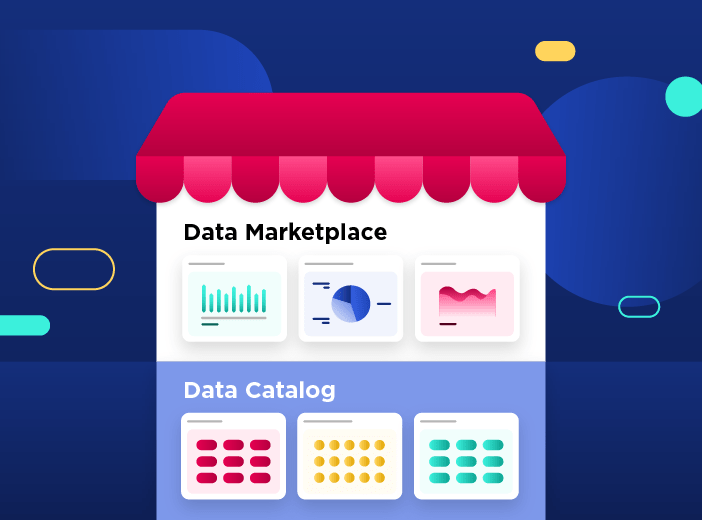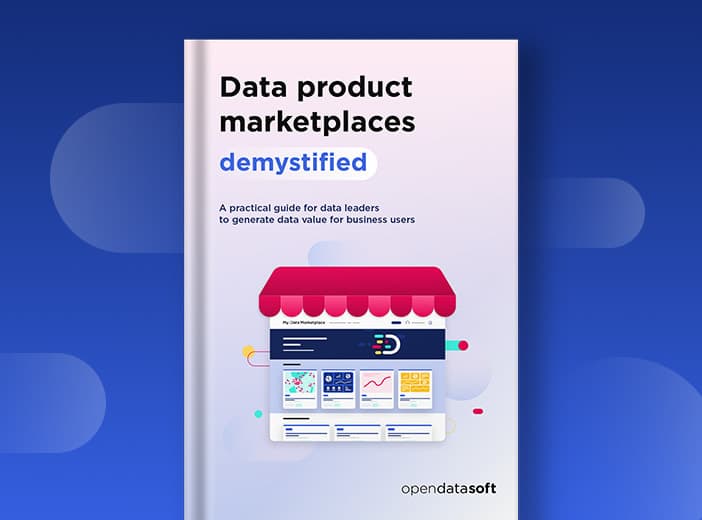Data marketplace and data catalog: which should you choose to maximize data access across your organization

Today’s enormous growth in data volumes brings a new challenge for businesses – how can they harness and use this data at scale? Organizations are therefore looking for solutions that can transform their data assets by making them available and useful, accelerating and improving performance to benefit the entire business.
While technical data catalog solutions have previously been seen as key to data management, they are starting to reach the limits of their capabilities. Thanks to this, data marketplaces are now increasingly being adopted to overcome the challenge of providing self-service data sharing across the entire organization, meeting the needs of all teams and departments. Data marketplaces open up new possibilities for data sharing. They allow organizations to maximize the value of their data by seamlessly sharing information internally on a large scale. This enables all employees to access and benefit from data, without requiring specialist skills or support, improving productivity and efficiency while delivering competitive advantage.
Data catalog: a comprehensive data inventory for data stewards
In order to understand why traditional data catalog tools are reaching their limits compared to data marketplaces, it is worth taking a step back and understanding their primary function.
The data catalog was created to meet the need for organizations to build a centralized inventory of all of its data assets. Just like the product inventory of a retail store, the data catalog identifies, organizes and describes these data assets through comprehensive metadata. Its features include a catalog of data assets, a business glossary, data lineage, and governance capabilities. This provides organizations with a complete and detailed view of their data estate, something which is particularly vital for large companies with a wide range of data assets scattered throughout the business.
However, from their inception data catalogs have been designed primarily to be used by data experts, such as data stewards and data engineers. While they aim to structure and document assets, they are simply too complex to be used by business teams, hampering wider adoption. Technical, basic interfaces make navigation difficult, and the user experience confusing. As a data catalog doesn’t provide direct access to data, business users struggle to benefit from using them. This means that while companies may want to become data-driven, expanding the use of data at scale is often difficult to achieve.
Data marketplace: a new way to scale data use
To maximize data use, data marketplaces, also known as internal data portals, enterprise data marketplaces, or data exchanges, are now emerging as a complementary and necessary alternative to data catalogs. These solutions are built on a radically different approach. Inspired by e-commerce interfaces and focused on the user experience, they aim to encourage adoption by the wider business, accelerating the use of data at scale. They allow data producers to publish their data products, and data consumers to discover, understand and consume this information directly through an intuitive and user-friendly interface.
Designed to promote user engagement, they are a key component in the data mesh approach, which decentralizes data management and empowers every part of the organization to manage and share its own data as products. Data marketplaces are a perfect fit for data mesh as they make it easier to share and use data across the enterprise.
Internal data marketplaces offer business users a fluid and intuitive experience, directly inspired by online shopping journeys. Advanced search capabilities – often powered by AI – make it possible to quickly find relevant assets or data products, even when queries are imprecise.
Data assets are presented as products, with dedicated pages detailing their content, origin, format, and even showing sample data. The ability to interact, share reviews, and request access with just a few clicks revolutionizes data access. Capabilities that automatically recommend similar data assets provide users with a fuller experience, in the same way that online retailers might recommend complementary products. All of this increases user consumption of relevant data.
This self-service approach removes the need for users to ask for data, shortening time to value and driving adoption at scale. As a result, organizations benefit from faster return on investment through increased operational efficiency and a significant reduction in the time to research and make decisions.
Data marketplaces: the key tool for democratizing data use
The adoption of data marketplaces is increasing rapidly due to their ability to harness data and use it to drive greater innovation and improved performance. Unlike data catalogs, they are focused on the needs of business teams, providing them with direct access to relevant, useful data, delivered through a user experience built on advanced, collaborative features. These capabilities allow users to showcase their own data assets, create custom spaces for sharing, and foster a vibrant community around key information.
Data marketplaces also dramatically improve operational efficiency by streamlining access to useful data and eliminating data duplication, all while engaging users and driving adoption. They focus on sharing data to maximize value for the business rather than simply inventorying the organization’s entire data estate. By providing a single source of access to relevant data, they strengthen user confidence that they are using the best available information, saving time through an intuitive, self-service experience.
Some of the most useful features provided by data marketplaces include powerful data visualizations, which allow information to be quickly understood and interpreted, and the ability to cross-reference different datasets for deeper analysis. Built-in collaboration tools also create a strong community around data User interactions are also helped through built-in collaborative tools, such as data-driven use case sharing which help users share real-time insights and inspire other employees to work with data.
Additionally, data marketplaces deliver the highest level of security and granular access management, ensuring efficient data sharing while adhering to corporate data governance policies. Through these capabilities, data marketplaces become true enablers of increased productivity, supporting faster and better-informed decision-making within organizations.
Data catalog and data marketplace: which combination should you choose?
Despite the advantages of data marketplaces, data catalogs still offer specific benefits and are far from being obsolete. In some cases, the best strategy is to combine the two solutions. This is because data catalogs remain essential for building a comprehensive inventory of data assets, especially for the technical experts that manage all of an organization’s information. They can underpin data governance programs, which are essential to structuring and organizing the company’s data estate. By contrast, data marketplaces focus on the operational use of data. They do not seek to necessarily collect and make available all data assets, just those that can deliver value to the business.
An effective governance strategy should either combine both tools, or choose the best to meet the organization’s specific needs. Here are the two most common scenarios when choosing between the two options:
- For data teams who need to inventory the organization’s data assets, a technical data catalog is the best start point. However, a data catalog alone is not enough to break down data silos or drive business value. It is therefore crucial to add a data marketplace to increase the use of data and maximize its value, thus justifying the work and investment made in data. In this scenario, Opendatasoft’s solution delivers ROI thanks to its close integration with the organization’s chosen technical data catalog solution.
- For data leaders looking to democratize data internally at scale, a data marketplace, combined with a modern data catalog that only captures data that is useful to the business – and offers features such as a business glossary and technical lineage – provides a solid foundation for success. In this case, Opendatasoft is the perfect fit thanks to its combination of a modern data catalog and a data marketplace solution in a single tool.
Delivering benefits across every sector
Whatever sector organizations operate in, data marketplaces help businesses to maximize and widen their use of data, transforming information into competitive advantage. Examples include:
Insurer Lamie Mutuelle, which provides health and property cover to 85,000 people, wanted all of its data to be reusable and usable by staff. It therefore created a centralized data marketplace that feeds multiple decision-making dashboards, provides 360° customer views, and drives its CRM solution and customer apps such as its web-based member area. This is helping the insurer become more data-centric, efficient and responsive to customer needs.
Real estate company ICF Habitat manages a portfolio of 95,000 homes. To deliver more strategic and responsive property management it has created a data marketplace to centralize all of its information, providing employees with advanced analytical tools and intuitive dashboards. This has significantly improved operational efficiency, reduced data management costs, and optimized the services provided to tenants.
Data marketplaces provide organizations with modular ways to make it easier to explore, reuse, and access data at scale. They can be tailored to meet the specific needs of individual organizations, whether it’s providing a more intuitive alternative to a traditional data catalog or complementing an existing solution to maximize data usage.
Data marketplaces: the best approach to democratizing data access and consumption
The real power of data marketplaces lies in their ability to transform the user experience, applying a self-service, e-commerce-style interface to the process of finding and using data. This guarantees data consumption at scale across the business and is at the heart of creating a data-centric organization. They offer an intuitive interface that presents data as products, with intelligent search engines and tailored recommendations making it easy for everyone to access and use information effectively. As on an e-commerce site, the user is guided along a clear, understandable journey, from their first click to their direct consumption of data.
Beyond this intuitive experience, collaborative features transform data and make it dynamic, strengthening engagement between producers and data consumers. This approach, combined with the ability to customize the data marketplace with the organization’s brand and design guidelines builds trust and enables business users to quickly take ownership of the solution. However, no matter how intuitive technology is, to drive data democratization organizations also need to build a data culture internally. This requires education, training and change management initiatives to explain the positive benefits of data and encourage everyone to use information throughout their working lives.
Are you interested in implementing a data marketplace? Find out how Opendatasoft can help you on this journey.

In today’s data-driven world, many organizations struggle to scale data consumption, with their data scattered across multiple systems, making it hard to access, understand, and leverage effectively. How can organizations transform this raw data into value, enabling it to drive decision-making, innovation, and AI adoption? This practical guide helps Chief Data Officers (CDOs) and data leaders to transform their data strategy and meet their goals by implementing self-service data product marketplaces.

Data catalogs are fundamental tools to inventory data, but are not sufficient to truly democratize it. Discover why the creation of a data marketplace is essential to unlock true value and build a data-driven organization.

Organizations now generate an enormous range of data assets across their operations and departments. Harnessing this data successfully starts with understanding what data is available and where it is located through centralized data catalogs. This blog explains what they are and how they can benefit businesses.
